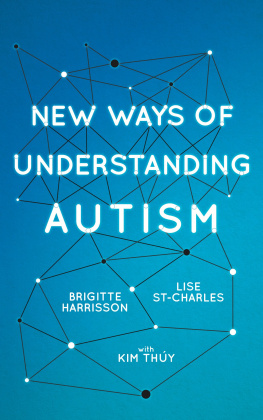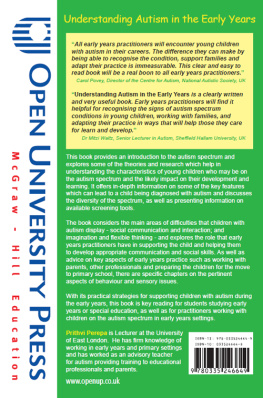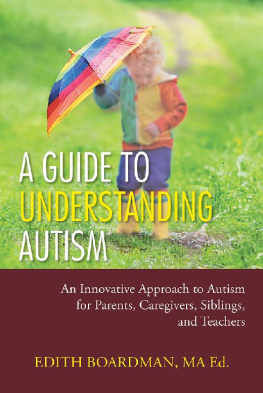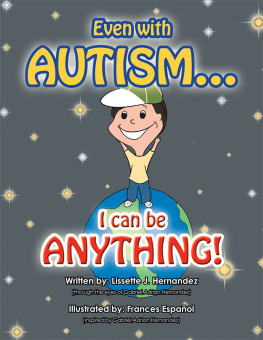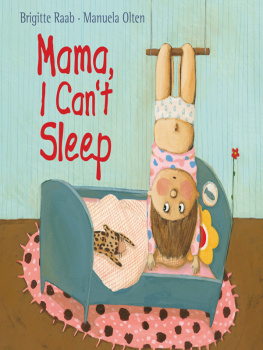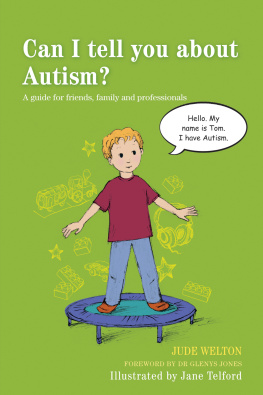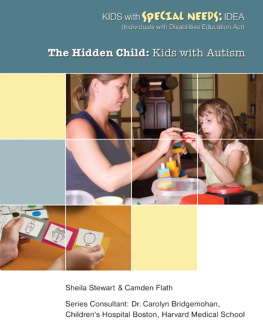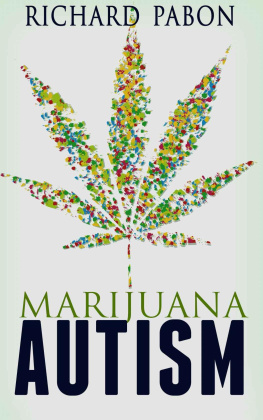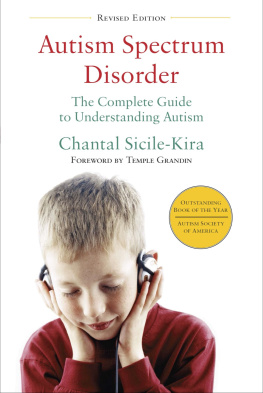Brigitte Harrisson - New Ways of Understanding Autism
Here you can read online Brigitte Harrisson - New Ways of Understanding Autism full text of the book (entire story) in english for free. Download pdf and epub, get meaning, cover and reviews about this ebook. year: 2019, publisher: Dundurn Press, genre: Politics. Description of the work, (preface) as well as reviews are available. Best literature library LitArk.com created for fans of good reading and offers a wide selection of genres:
Romance novel
Science fiction
Adventure
Detective
Science
History
Home and family
Prose
Art
Politics
Computer
Non-fiction
Religion
Business
Children
Humor
Choose a favorite category and find really read worthwhile books. Enjoy immersion in the world of imagination, feel the emotions of the characters or learn something new for yourself, make an fascinating discovery.
- Book:New Ways of Understanding Autism
- Author:
- Publisher:Dundurn Press
- Genre:
- Year:2019
- Rating:3 / 5
- Favourites:Add to favourites
- Your mark:
- 60
- 1
- 2
- 3
- 4
- 5
New Ways of Understanding Autism: summary, description and annotation
We offer to read an annotation, description, summary or preface (depends on what the author of the book "New Ways of Understanding Autism" wrote himself). If you haven't found the necessary information about the book — write in the comments, we will try to find it.
New Ways of Understanding Autism — read online for free the complete book (whole text) full work
Below is the text of the book, divided by pages. System saving the place of the last page read, allows you to conveniently read the book "New Ways of Understanding Autism" online for free, without having to search again every time where you left off. Put a bookmark, and you can go to the page where you finished reading at any time.
Font size:
Interval:
Bookmark:

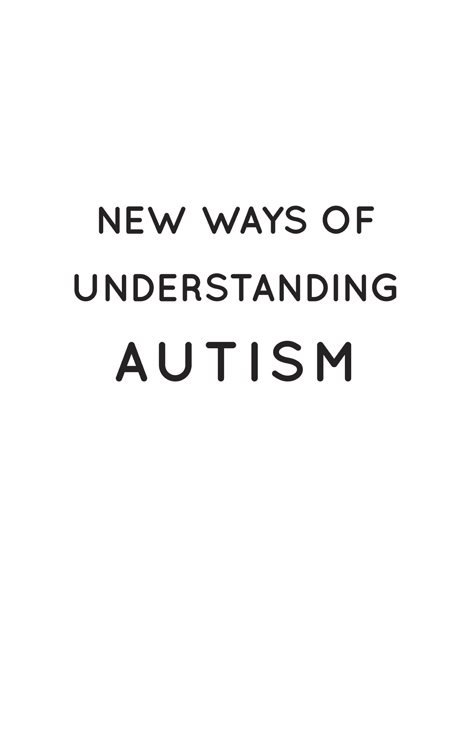

Copyright Dundurn Press, 2019
Originally published in French under the title LAutisme expliqu aux non-autistes.
Copyright 2017 ditions du Trcarr. Published under arrangement with Groupe Librex Inc., doing business under the name ditions du Trcarr, Montreal, QC, Canada.
All rights reserved. No part of this publication may be reproduced, stored in a retrieval system, or transmitted in any form or by any means, electronic, mechanical, photocopying, recording, or otherwise (except for brief passages for purpose of review) without the prior permission of Dundurn Press. Permission to photocopy should be requested from Access Copyright.
Printer: Webcom, a division of Marquis Book Printing Inc.
Cover concept: Stefano Pietramala (STUDIO IANUS, Milan)
Library and Archives Canada Cataloguing in Publication
Title: New ways of understanding autism / Brigitte Harrisson, Lise St-Charles, with Kim Thy; translated by Juliet Sutcliffe.
Other titles: Autisme expliqu aux non-autistes. English Names: Harrisson, Brigitte, 1961- author. | St-Charles, Lise, 1957- author. | Thy, Kim, author.
Description: Translation of: Lautisme expliqu aux non-autistes. | Includes bibliographical references.
Identifiers: Canadiana (print) 20189068701 | Canadiana (ebook) 2018906871X | ISBN 9781459743601 (softcover) | ISBN 9781459743618 (PDF) | ISBN 9781459743625 (EPUB)
Subjects: LCSH: Autism spectrum disordersMiscellanea.
Classification: LCC RC553.A88 H37213 2019 | DDC 616.85/882dc23
1 2 3 4 5 23 22 21 20 19

This translation was made possible by the financial support of Socit de dveloppement des enterprises culturelles (SODEC). We also acknowledge the support of the Canada Council for the Arts, which last year invested $153 million to bring the arts to Canadians throughout the country, and the Ontario Arts Council for our publishing program. In addition, we acknowledge the financial support of the Government of Ontario, through the Ontario Book Publishing Tax Credit and Ontario Creates, and the Government of Canada.
Nous remercions le Conseil des arts du Canada de son soutien. Lan dernier, le Conseil a investi 153 millions de dollars pour mettre de lart dans la vie des Canadiennes et des Canadiens de tout le pays.
Care has been taken to trace the ownership of copyright material used in this book. The authors and the publisher welcome any information enabling them to rectify any references or credits in subsequent editions.
J. Kirk Howard, President
The publisher is not responsible for websites or their content unless they are owned by the publisher.
Printed and bound in Canada.
VISIT US AT
 dundurn.com
dundurn.com
 @dundurnpress
@dundurnpress
 dundurnpress
dundurnpress
 dundurnpress
dundurnpress
Dundurn
3 Church Street, Suite 500
Toronto, Ontario, Canada
M5E 1M2
THE LANGUAGE SURROUNDING autism is currently in flux. Until recently, person first language was in general use a person with autism was preferred. The standard usage has been changing, however, as people with autism increasingly join the conversation. In New Ways of Understanding Autism, identification-first language is used an autistic person as it is becoming increasingly prevalent. Autistic people who prefer the term often explain their choice thus: autism is not something I have; autism is an integral part of who I am. Although a decision has been made on appropriate usage for this book, autistic people should always be consulted about how they would prefer to be addressed.
PEOPLE ARE CONSTANTLY asking questions about autism. How does an autistic person perceive the world? Why does she make all those movements? How does he feel? Is he all right? These questions come up all the time, and answers are often offered by people who arent aware of current developments in autism research in the scientific literature. So what are the answers?
This book aims to present clearly the directions suggested by recent discoveries and theories, combining knowledge of autistic functioning and a new understanding of what it means to treat autism. Descriptions are written from the perspective of an autistic person, to allow neurotypical readers a basis for comparison with their own experience. Until now, most writing on autistic function has been based on a neurotypical persons viewpoint, which led to an analysis that did not give a logical and coherent picture of autism. In this book, we bring together the lived experience of autistic people, real-life stories from parents, and suggested therapeutic approaches to show readers that there is hope for autistic people.
Brigitte: I remember a time when I was all alone, struggling to do what people told me to do, never enjoying life because everything I did was what others had asked of me. I could never be myself. I could never value myself as an individual because I was surrounded by neurotypical people who did the same things as I did, but for different reasons. I had a key ring that read Just visiting this planet. And that was my reality. I did things for other people. I could never do anything for me. The outside world guided my life. I wasnt in my own little world, but stuck, with my autistic brain oriented outward. I ate because it was lunchtime. My showers lasted seven minutes thirty-three seconds. And so on. Life had no meaning.
These approaches to interpretation and treatment come mainly from Fonctionnement interne de la structure de la pense autistique (Harrisson 1993), which are helping autistic people communicate. Just as sign language was developed by deaf people and Braille by a blind man, SCL was created by an autistic person.
Lise: Analyzing behaviour from ones own frame of reference is always tricky. If you dont know the frame of reference of another person or of a particular community, you can make big mistakes. One day I was in a conference room in a hotel. In the room opposite, some Japanese tourists were burping loudly during their meal. The people I was with were quick to remark on the rudeness of these tourists. I had to explain to them that in Japan, people do this to show satisfaction after a meal. In a Quebec context, the noises were perceived as a lack of manners, whereas in Japan they are valued!
The needs of autistic people are almost always interpreted in the same way from a neurotypical viewpoint. We analyze and treat each need separately, without any consistent reference to the autistic function described in the literature. For example, if an autistic person presents with a severe sensory sensitivity, we often try to increase sensory stimulation to help her get used to it. But we should instead understand that she is behaving this way because shes at a particular developmental stage; she is standing in front of a door that she cant open, so she cant move on to the next developmental stage.
Font size:
Interval:
Bookmark:
Similar books «New Ways of Understanding Autism»
Look at similar books to New Ways of Understanding Autism. We have selected literature similar in name and meaning in the hope of providing readers with more options to find new, interesting, not yet read works.
Discussion, reviews of the book New Ways of Understanding Autism and just readers' own opinions. Leave your comments, write what you think about the work, its meaning or the main characters. Specify what exactly you liked and what you didn't like, and why you think so.

